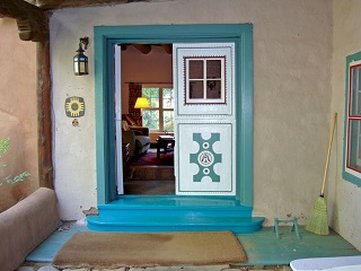"The El Santuario de Chimayo is considered the most important pilgrimage site in the United States. Its popularity owes to the curative powers of the “Tierra Bendita” or “holy dirt” found in a small hole in a precept off the main altar. For nearly 200 years, the dirt is believed by many to have miraculous healing powers over a wide variety of ailments and afflictions. One of the most visited tourist attractions in New Mexico, the Santuario hosts over 300,000 visitors a year. During Holy Week alone, over 30,000 people from all over the world make the pilgrimage to Chimayo. The local tradition is to walk, and people walk to Chimayo from all over the state of New Mexico, some traversing over 100 miles. Some people make the journey barefoot or on their hands and knees, and others carry enormous wooden crosses or put cactus needles in their shoes in order to demonstrate their devotion. As the legend goes, in 1810, a member of the local Penitente order was performing his rites when he saw a light emanating from a hillside near the Santa Cruz river. As he approached the light, he was surprised to discover that it was originating from beneath the ground. He started to dig, and found a rather large crucifix bearing a black Christ. He left the Christo sticking out of the ground, and ran back to get his brothers, so they could perform the appropriate benedictions. The crucifix, known as “Nuestro de Senor de Esquipulas” or the “Black Christ of Esquipulas,” was instantly considered highly sacred and was brought to the nearby church at Santa Cruz in a ceremonial procession and placed in the high altar. The next day, the Christo was gone, and was eventually found in the hole where it came from. This happened three times before the priests, weary of making the procession from Chimayo to Santa Cruz, decided to build a small chapel over the hole where the crucifix was found. Almost immediately, the dirt from the hole started to effect miraculous healing cures. Word spread, and eventually, in 1816, the small chapel was razed and the Santuario was built to accommodate the increasing numbers of pilgrims. The story of how a crucifix from Esquipulas, a small town in Guatemala, came to be buried in a remote location in the New Mexico wilderness, was a mystery until someone discovered documents from the Diocese in Durango that tell the story of a Guatemalan priest who had come with the first settlers of Chimayo. The priest from Esquipulas preached to the local Indians and carried around a large crucifix. The Indians rebelled and killed the priest, and he was buried by the settlers, who used the crucifix to mark his grave. In 1810, the Santa Cruz river flooded, and the crucifix and body of the priest were uncovered. Those who remembered the priest exclaimed “That is the padre from Esquipulas!” and that is how the Christo’s origins were known. Interestingly, Esquipulas is also a holy pilgrimage site known for it’s clay which is said to have curative powers, and the site where the crucifix was found was already considered sacred by the Tewa Indians long before the Spanish even arrived. When visiting Chimayo, it is customary to make a small donation and bring some kind of offering, such as a candle, a rosary, a personal note, or a picture of a loved one to leave on the outdoor altar. It is also recommended that you bring a small container if you would like to take home some holy dirt. The dirt is traditionally eaten, dissolved in water, or made into a poulstice and applied to wounds, but most people prefer to keep it on their altar. The Navajo tradition is to hang the dirt in a basket in the East and let it sprinkle freely about the house. Belief in the curative powers of the dirt is purely faith based. The priests of Chimayo have clean fill dirt trucked in from off-site and routinely replenish the supply in the hole, where it is consecrated. Whether or not you are a person of faith, or believe in the healing powers of the holy dirt, the sacredness of the site cannot be denied. Many people experience a profound welling of emotions, strange bodily sensations, and a myriad of other physical, emotional and spiritual effects while on location. Besides, a taste of Chimayo’s famous red chile, also believed by many to have miraculous healing properties, is worth the trip alone." - ATLAS_OBSCURA















